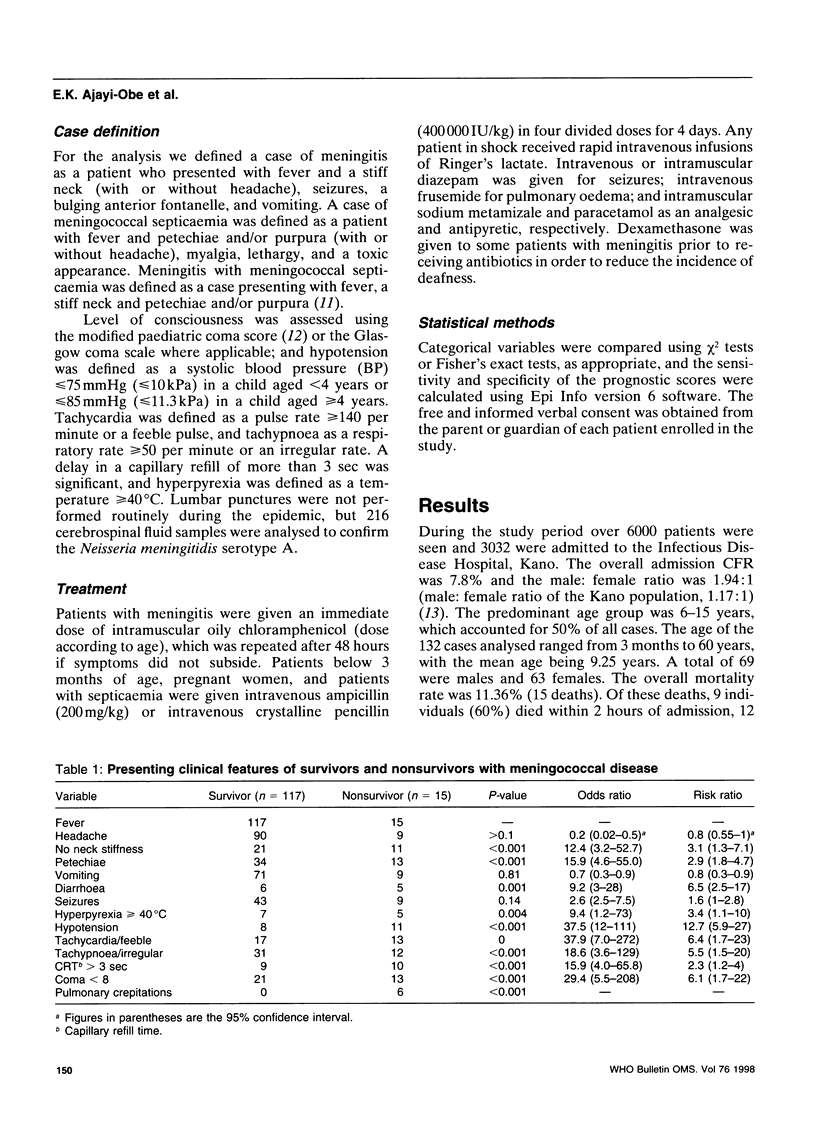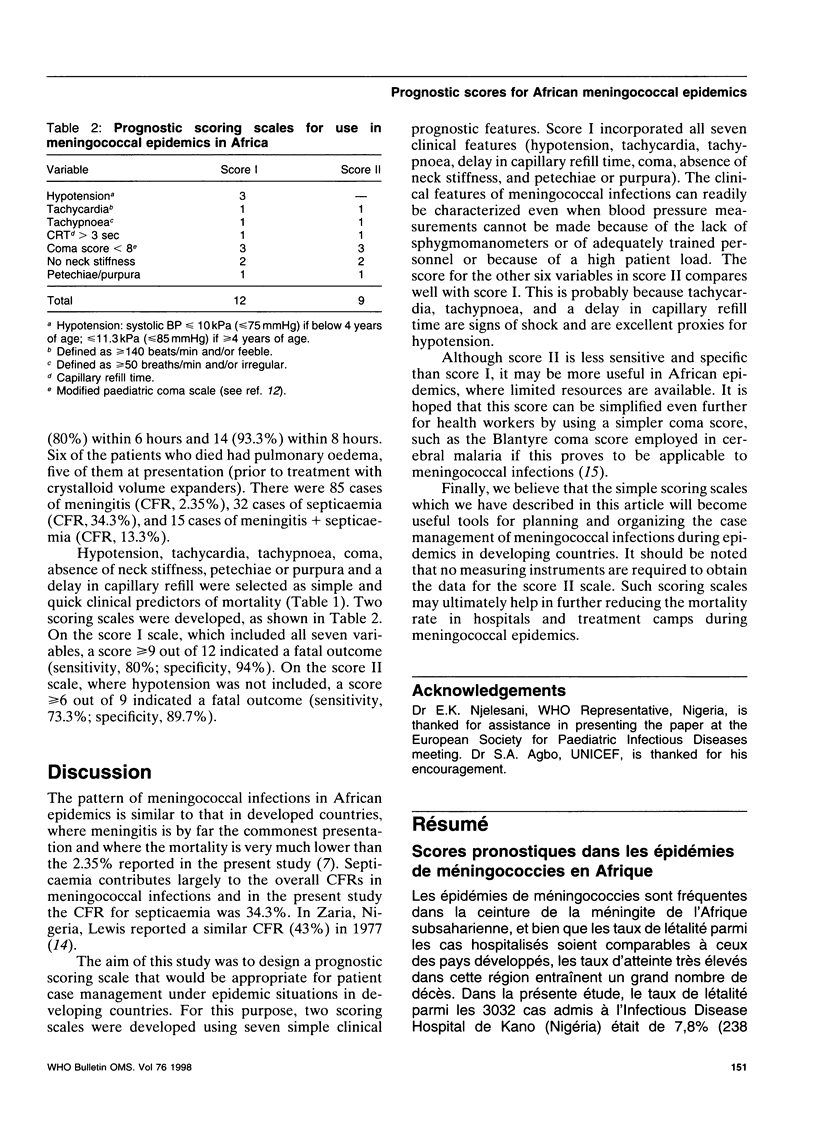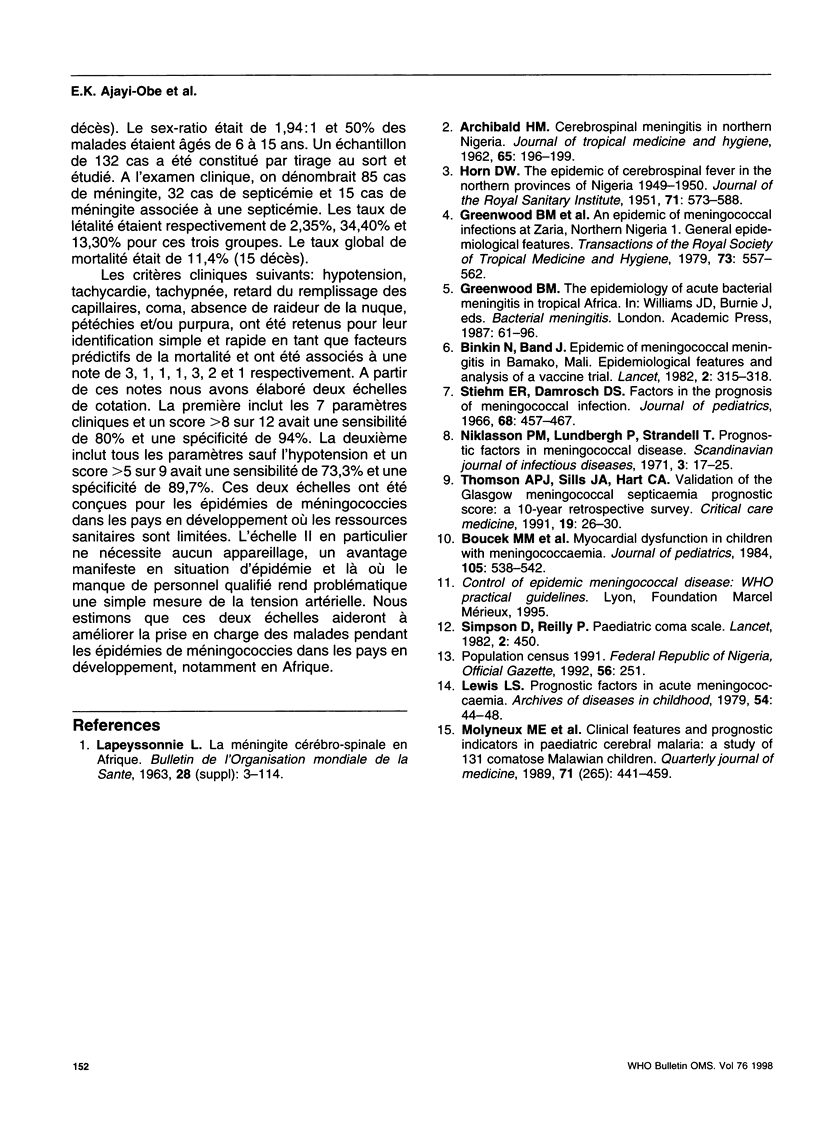Abstract
Current WHO guidelines for the case management of meningococcal infections during epidemics in developing countries often cannot be applied, largely because of the limited health resources in such countries. Several scoring scales based on clinical and laboratory features in numerous combinations have been developed for the management of meningococcal infections in developed countries, and these have facilitated early identification of patients with fulminant disease and thus early intervention and reduction in mortality. Unfortunately such scoring scales are not appropriate for use in developing countries. We identified hypotension, tachycardia, tachypnoea, delay in capillary refill time, coma, absence of neck stiffness and petechiae and/or purpura as simple prognostic factors of meningococcal disease. Two scores were developed: score I, which includes all seven prognostic factors, had a sensitivity and specificity of 80% and 94%, respectively. Score II, which excluded hypotension, had a sensitivity and specificity of 73.3% and 89.7%, respectively. Quick and simple scoring scales are therefore not only applicable but useful for the case management of patients in meningococcal epidemics in developing countries.
Full text
PDF



Selected References
These references are in PubMed. This may not be the complete list of references from this article.
- Binkin N., Band J. Epidemic of meningococcal meningitis in Bamako, Mali: epidemiological features and analysis of vaccine efficacy. Lancet. 1982 Aug 7;2(8293):315–318. doi: 10.1016/s0140-6736(82)90282-3. [DOI] [PubMed] [Google Scholar]
- Greenwood B. M., Bradley A. K., Cleland P. G., Haggie M. H., Hassan-King M., Lewis L. S., Macfarlane J. T., Taqi A., Whittle H. C., Bradley-Moore A. M. An epidemic of meningococcal infection at Zaria, Northern Nigeria. 1. General epidemiological features. Trans R Soc Trop Med Hyg. 1979;73(5):557–562. doi: 10.1016/0035-9203(79)90052-x. [DOI] [PubMed] [Google Scholar]
- HORN D. W. The epidemic of cerebrospinal fever in the northern provinces of Nigeria, 1949-1950. J R Sanit Inst. 1951 Sep;71(5):573–589. doi: 10.1177/175791395107100517. [DOI] [PubMed] [Google Scholar]
- Lewis L. S. Prognostic factors in acute meningococcaemia. Arch Dis Child. 1979 Jan;54(1):44–48. doi: 10.1136/adc.54.1.44. [DOI] [PMC free article] [PubMed] [Google Scholar]
- Molyneux M. E., Taylor T. E., Wirima J. J., Borgstein A. Clinical features and prognostic indicators in paediatric cerebral malaria: a study of 131 comatose Malawian children. Q J Med. 1989 May;71(265):441–459. [PubMed] [Google Scholar]
- Niklasson P. M., Lundbergh P., Strandell T. Prognostic Factors in meningococcal disease. Scand J Infect Dis. 1971;3(1):17–25. doi: 10.3109/inf.1971.3.issue-1.03. [DOI] [PubMed] [Google Scholar]
- Simpson D., Reilly P. Pediatric coma scale. Lancet. 1982 Aug 21;2(8295):450–450. doi: 10.1016/s0140-6736(82)90486-x. [DOI] [PubMed] [Google Scholar]
- Stiehm E. R., Damrosch D. S. Factors in the prognosis of meningococcal infection. Review of 63 cases with emphasis on recognition and management of the severely ill patient. J Pediatr. 1966 Mar;68(3):457–467. doi: 10.1016/s0022-3476(66)80250-0. [DOI] [PubMed] [Google Scholar]
- Thomson A. P., Sills J. A., Hart C. A. Validation of the Glasgow Meningococcal Septicemia Prognostic Score: a 10-year retrospective survey. Crit Care Med. 1991 Jan;19(1):26–30. doi: 10.1097/00003246-199101000-00010. [DOI] [PubMed] [Google Scholar]


